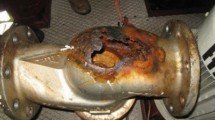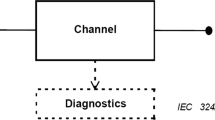Abstract
High integrity pressure protection systems (HIPPSs) have been maintained for many years in the oil and gas industry in order to prevent over-pressurizing of the pressure facilities. Fundamentally, the main function of a HIPPS is to protect downstream equipment from excess pressure by continuously monitoring the line pressure and automatically closing the isolation valve(s) if the pressure rises above a specific level. A HIPPS is a specific application of a safety instrumented system (SIS) designed according to the International Electro Technical Commission (IEC) 61,508. This paper reviews the implementation of a state-of-the-art HIPPS for the subsea sector of the oil and gas industry. The different parameters that lead to subsea pipeline cost reduction due to HIPPS implementation are also reviewed in this paper. In addition, the usage of HIPPS for flare lines and relevant schematics are discussed. The paper introduces a case study of a 28” Class 150 HIPPS valve on a flare line. Four options of valves including ball, butterfly, through conduit gate (TCG) and axial are selected for the application. Value engineering methodology is used in order to select the most optimum valve for the application. The valves are compared based on one commercial and six technical parameters. The results of the value engineering show that an axial valve is the most suitable valve for HIPPS application. A butterfly valve could be considered if the intention is to reduce the cost of expenditure (CAPEX). A TCG valve is not recommended for this application according to the results of value engineering.






Similar content being viewed by others
References
American Petroleum Institute (API) 17D. (2011). Design and operation of subsea production systems, subsea wellhead and tree equipment, 2nd ed. Washington, DC: API.
American Petroleum Institute (API) 520. (2014). Sizing, selection and installation of pressure relieving devices, 9th ed. Washington, DC: API.
American Petroleum Institute (API) 521. (2020). Pressure relieving and depressuring systems, 7th ed. Washington, DC: API.
American Petroleum Institute (API) 598. (2004). Valve inspection and testing, 8th ed. Washington, DC: API
American Petroleum Institute (API) 609. (2004). Butterfly valves: double flanged, lug-and wafer type, 6th ed. Washington, DC: API
American Petroleum Institute (API) 6A. (2018). Specification for wellhead and tree equipment, 21st ed. Washington, DC: API.
American Society for Testing and Materials (ASTM). Standard specification for forged or alloyed alloy steel pipe flanges, forged fittings, and valves and parts for high temperature service. ASTM A182. Washington, DC
American Society of mechanical Engineers (ASME) (2012). Rules for construction of pressure vessels. Boiler and Pressure Vessel Code. ASME Section VIII Div.01. New York, NY.
Bai, Y. & Bai, Q. (2012). Subsea engineering handbook. 1st edition. Atlanta, GA, USA: Elsevier.
Bingham K. & Lawson S. (2007). High integrity pressure protection systems for cost-effective risk reduction. Process west.
Davalath J., Skeels H.B. & Corneliussen S. (2002). Current state of the art in the design of subsea HIPPS systems. Offshore technology conference. Paper # OCT 14183. Houston, Texas.
De Waard C, Lotz U, Milliams DE (1991) Predictive Model for CO2 Corrosion Engineering in Wet Natural Gas Pipelines. Journal of Corrosion. 47(12):976–985
Det Norske Veritas (2010) Submarine pipeline systems. DNV-OS-F101.Hovik, Norway
Emerson (2016). A complete solution for HIPPS. [online] retrieved from: https://www.emerson.com/documents/automation/brochure-high-integrity-pressure-protection-system-en-86238.pdf [ access date: 29th December 2012]
EnggCyclopedi (2020). Choke valves.[online] available at : https://www.enggcyclopedia.com/2012/03/choke-valves/ [accessed: 17th July, 2020]
Equinor Europe (2020). Piping and valve material selection. [online] available at: https://www.tr2000.no/TR2000/index.jsp [accessed: 20th July, 2020]
ESI Technologies Group (2018). SIL certified ball valves and actuators: A brief review of SIL. [Online]. Available from: https://esitechgroup.com/blog/sil-certified-ball-valves/ [accessed: July 17, 2020]
Hernandez R., Patel R., Attaway T., Shah V. & Asi. S (2016). Implementation and challenges of SIL3 subsea HIPPS. Offshore technology conference, Houston, Texas, USA. Paper # OTC-2728-MS
Herwibowo A.J., Sulistiyo A. & Sinaga H.A. (2018). Saving millions USD by knowing strength and weakness of various wellhead choke valves for sandy wells. Proceeding Indonesian petroleum association.
Huang Y, Jiang W (2018) Extension of TOPSIS method and its application in investment. Arabian Journal for Science and Engineering. Springer. 43:693–705. https://doi.org/10.1007/s13369-017-2736-3
Hutchings V. (2010). Is the subsea high integrity pressure protection system (HIPPS) coming of age? Society of underwater technology. Subsea control and data acquisition (SADA) Conference, June 2–3, Newcastle, UK.
International Electrotechnical Commission (IEC). (2010). IEC 61508, Functional safety of electrical/electronic/programmable electronic safety-related systems, 2nd edition. Geneva, Switzerland.
International Organization for Standardization (ISO 5208) (2015). Industrial valves— pressure testing of metallic valves. 4th edition. Geneva. Switzerland.
Iranian Petroleum Standard (IPS) (2008). Engineering Standard for Corrosion Consideration in Material Selection. IPS-E-TP-740, Tehran, Iran.
Luis M., Garcia G., Fialkowski C., Sud V., Christopher Ng. (2015). HIPPS design, analysis, justification and implementation. Siemens Industry. Safety control systems conference.
Marszal E.M., Mitchell K. (2004). Justifying the use of high integrity pressure protection systems. Pressure vessel and piping conference. American society of mechanical engineering. Paper # PVP2004-3023, pp.207-212.
Mokveld (2020). HIPPS. [online] available at: https://mokveld.com/en/hipps [accessed: July 21, 2020]
Nesbitt B (2007) Handbook of valves and actuators: valves manual international. 1st edition. Elsevier, Oxford
Nustad G (2015) Tackling Corrosive Challenges in the Oil and Gas Industry. Valve World 20(11):56–60
Rachwan R, Abotaleb I, Elgazouli M (2016) The influence of value engineering and sustainability considerations on the project value. Elsevier. Procedia environmental sciences. 34:431–438. https://doi.org/10.1016/j.proenv.2016.04.038
Schlumberger (2020). Oilfield glossary. [online] available at : https://www.glossary.oilfield.slb.com/en/Terms/f/flow_line.aspx [accessed: July 14, 2020]
Signoret J.P. (2007). HIPPS-Making SIL calculations effective. Touch briefings.
Sotoodeh K (2016a) HIPPS application—A case study of suitable fast opening valve selection. Valve World Magazine. 21(10):61–65
Sotoodeh K (2016b) Soft material selection, application and the implications on valve design. Valve World Magazine 21(08):51–55
Sotoodeh K (2018a) Analysis and improvement of material selection for process piping system in offshore industry. American Journal of Mechanical Engineering 6(1):17–26. https://doi.org/10.12691/ajme-6-1-3
Sotoodeh K (2018b) Why are butterfly valves a good alternative to ball valves for utility services in the offshore industry? American. Journal of Industrial Engineering. 5(1):36–40. https://doi.org/10.12691/ajie-5-1-6
Sotoodeh K (2019a) A review on process and valve technology. Journal of Marine Systems & Ocean Technology 14:210–219. https://doi.org/10.1007/s40868-019-00061-4
Sotoodeh K (2019b) Safety integrity level in valves. Journal of Failure Analysis and Prevention. Springer. 19:832–837. https://doi.org/10.1007/s11668-019-00666-2
Sotoodeh K. (2019c). Actuator selection and sizing for valves. SN applied science.1, 1207. DOI: https://doi.org/10.1007/s42452-019-1248-z
Sotoodeh K (2019d) The importance of maximum allowable stem torque in valves. Springer Nature Switzerland 1:433. https://doi.org/10.1007/s42452-019-0445-0
Sotoodeh K (2020a) Requirement and calculation of corrosion allowance for piping and valves in the oil and gas industry. Journal of bio and tribo corrosion. Springer. 6:21. https://doi.org/10.1007/s40735-019-0319-4
Sotoodeh K (2020b) Valve selection in dirty process service. Valve World Magazine 25(5):58–60
Sotoodeh K (2020c) Optimized valve stem design in oil and gas industry to minimize major failures. Journal of failure analysis and prevention. https://doi.org/10.1007/s11668-020-00891-0
Sotoodeh K. (2021). Prevention of actuator emissions in the oil and gas industry. Elsevier. 1st edition. Oxford, UK
Thogersen C (2014) HIPPS—The challenges faced and the benefits of a solution, Valve World Conference 2014. Dusseldorf, Germany
TQC (2020). Useful leak specification guideline. [online] available at: http://www.leaktesting.co.uk/leak_spec_guidelines.htm [accessed: July 20, 2020]
Data availability statement
Data sharing not applicable to this article as no datasets were generated or analysed during the current study.
Funding
The authors have no relevant financial or non-financial interests to disclose.
Author information
Authors and Affiliations
Corresponding author
Ethics declarations
Conflict of interests
The authors have no conflicts of interest to declare that are relevant to the content of this article.
Rights and permissions
About this article
Cite this article
Sotoodeh, K. A review of high integrity pressure protection systems (HIPPSs) and challenges related to valve selection for HIPPS application for a flare line in an offshore project. Saf. Extreme Environ. 4, 47–58 (2022). https://doi.org/10.1007/s42797-022-00051-7
Received:
Revised:
Accepted:
Published:
Issue Date:
DOI: https://doi.org/10.1007/s42797-022-00051-7




